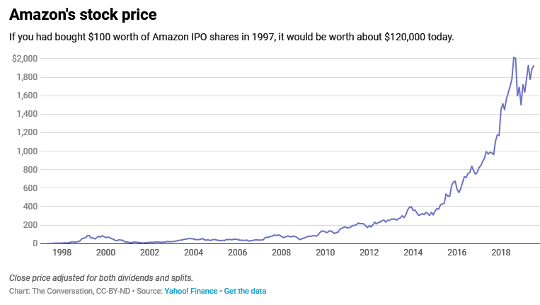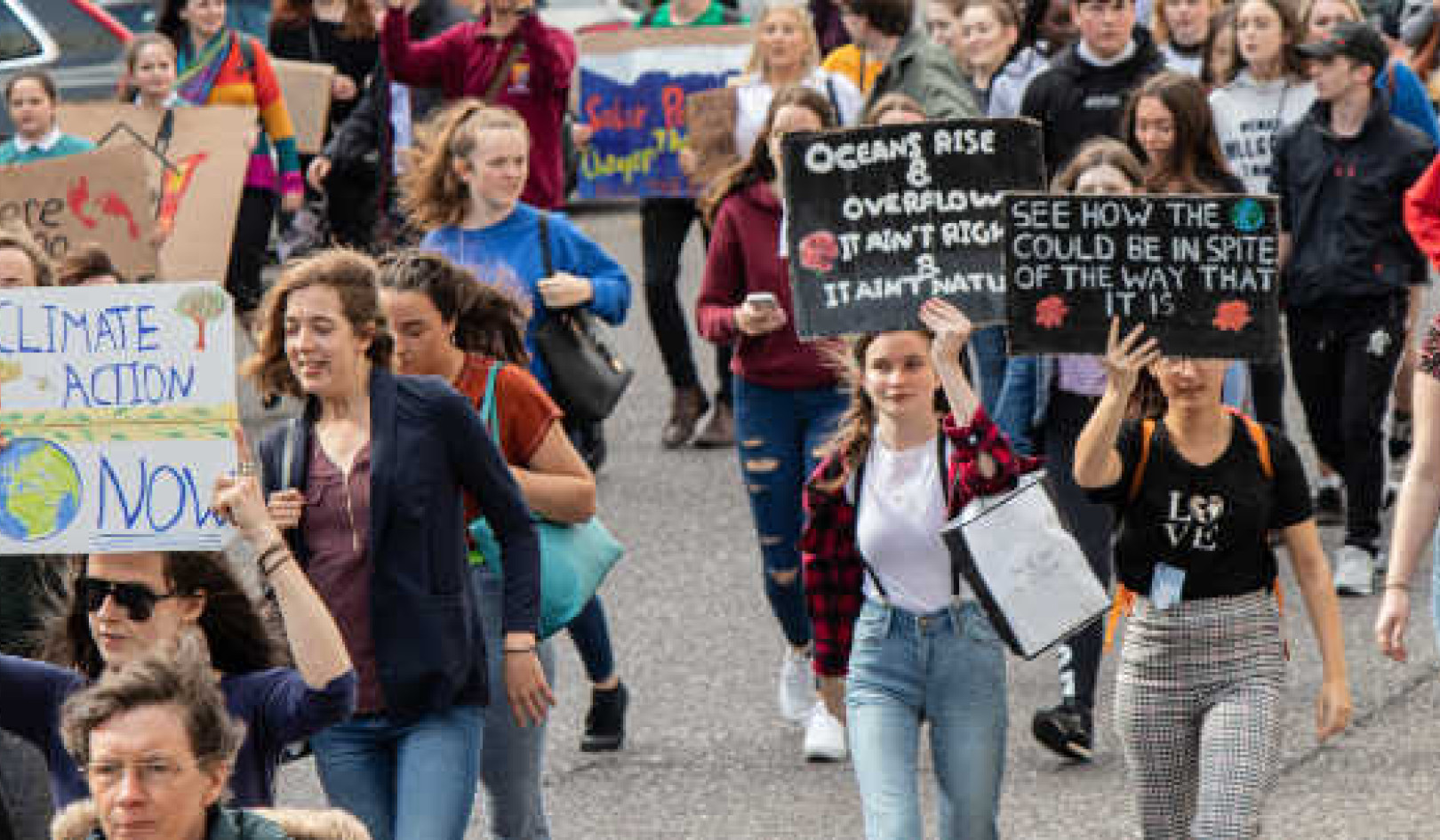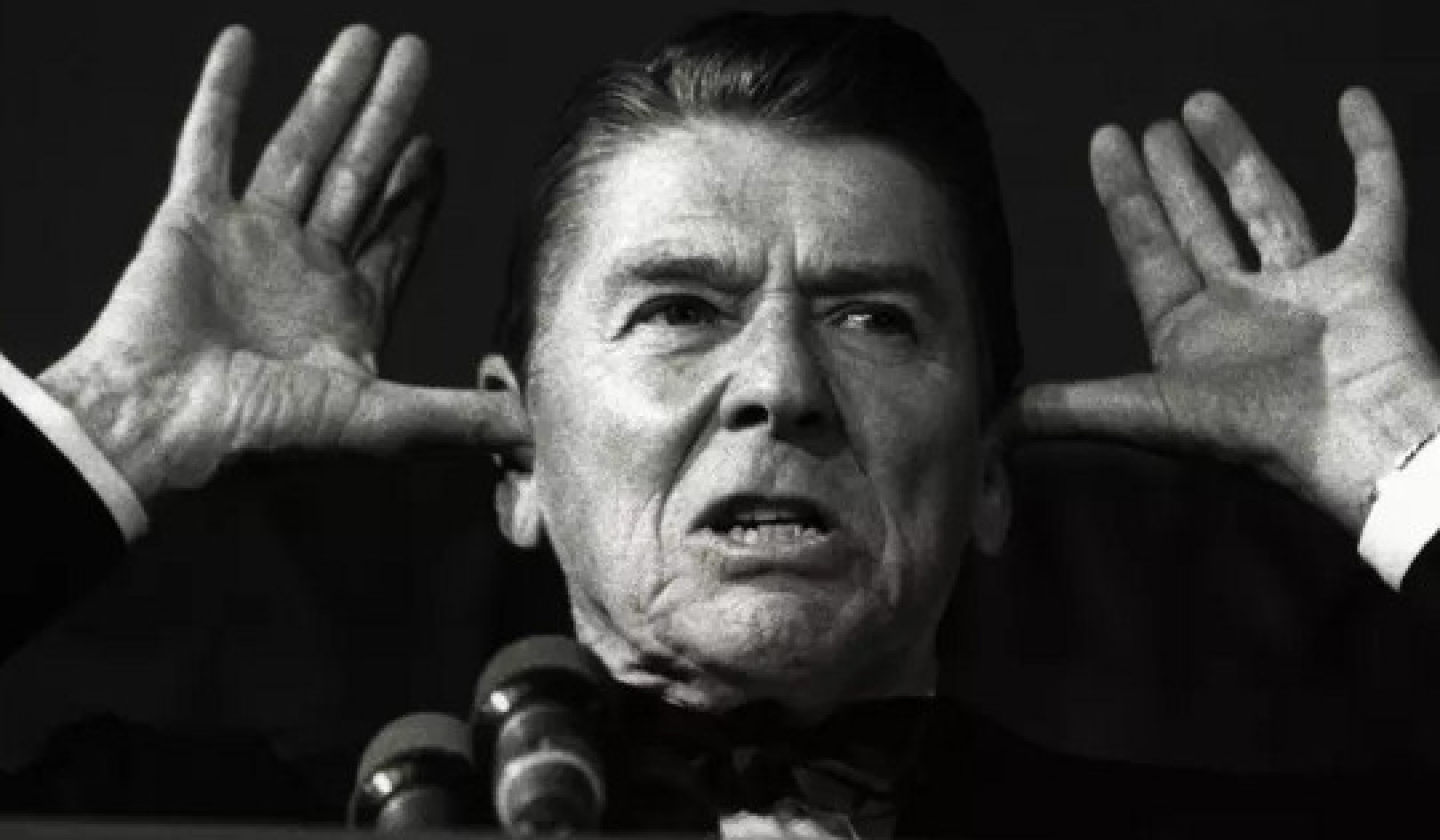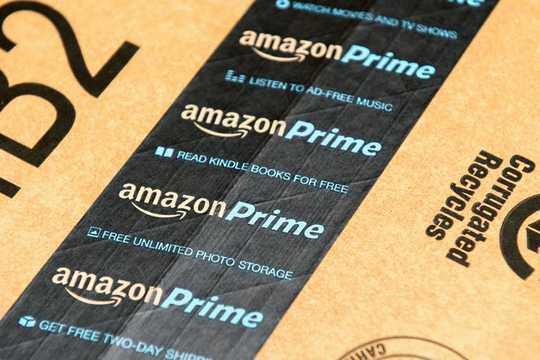 Amazon has redefined retail over the last 25 years. Hadrian/shutterstock.com
Amazon has redefined retail over the last 25 years. Hadrian/shutterstock.com
A quarter of a century ago, on July 5, 1994, a company, which shared a name with the world’s largest river, was incorporated. It sold books to customers who got to its website through a dial-up modem.
It wasn’t the first bookstore to sell online. (Books.com launched in 1992.) But it behaved like a local store, whose shopkeeper knew customers by name – a bell even rang in the company’s Seattle headquarters every time an order was placed.
Amazon’s founder, Jeff Bezos, set his sights on making it an “everything store.” The company would go on to become not just an everything store, but an “everything company.”
Today, 25 years later, Amazon has reshaped retailing permanently. It is one of the top three most valuable companies in the world, with a market capitalization hovering around US$1 trillion, greater than the GDP of nearly 200 countries.
If you had bought $100 worth of its IPO shares in 1997, it would be worth about $120,000 today.
Redefining retail
Amazon continually took shopping convenience to newer levels.
Before 1994, shoppers had to travel to stores to discover and buy things. Shopping used to be hard work – wandering down multiple aisles in search of a desired item, dealing with crying and nagging kids, and waiting in long checkout lines. Today, stores try to reach out to shoppers anywhere, anytime and through multiple channels and devices.
After first experiencing two-day free shipping from Amazon’s Prime membership program, shoppers started expecting no less from every online retailer. About 100 million shoppers worldwide have Amazon Prime.
The company made shopping more convenient through features like one-click ordering; personalized recommendations; package pickup at Amazon hubs and lockers; ordering products with the single touch of a Dash button; and in-home delivery with Amazon Key.
Shoppers can also search for and order items through a simple voice command to an Echo or by clicking an Instagram or a Pinterest image. Amazon now even has a cashierless “Go” store in Seattle.
Amazon has been a factor in the rising closures of brick-and-mortar stores that can’t keep pace with the changes in retail. In the first 15 weeks of 2019 alone, there were about 6,000 store closures in the U.S. overall, higher than the number of closures in all of 2018. Analysts fear a coming “retail apocalypse.”
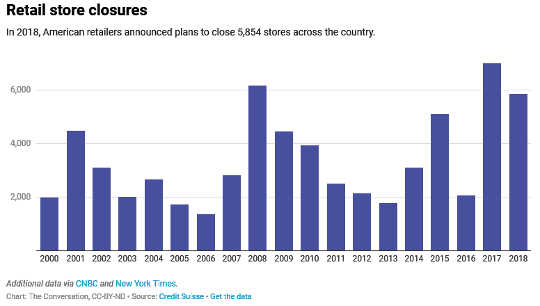
A major employer
Amazon’s impact extends to other industries, including smart consumer devices (Alexa), cloud service (Amazon Web Services), and technology products and services (drones).
Such is Amazon’s impact that industry players and observers use the term “Amazoned” to describe their business model and operations being disrupted by Amazon.
Today, Amazon is the largest tech employer by far. It employs more people than the next five tech companies combined. No wonder Amazon created such a buzz last year before selecting a location for its second headquarters.
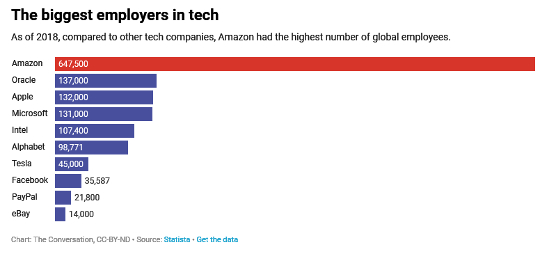
Amazon’s work culture is intense. It has a reputation as a cutthroat environment with a high employee burnout rate. It is automating as many jobs as possible, mostly in warehousing.
At the same time, after criticism from policymakers, Amazon stepped up in October 2018 by raising minimum wage for all U.S. employees to $15 per hour.
Faced with growing criticisms about the mounting impact of Amazon’s boxes and other packaging material on the environment, Amazon has pledged to disclose more information about its environmental impact at the end of 2019.
The next generation
What’s in store for Amazon’s future?
 The Amazon Echo Plus. ClassyPictures/shutterstock.com
The Amazon Echo Plus. ClassyPictures/shutterstock.com
Bezos has said that Amazon’s efforts focus on preventing it from dying. As he noted at a 2018 all-hands meeting, “Amazon is not too big to fail.”
As a professor of marketing, having conducted research on online retailing and analyzed hundreds of cases, I believe that Amazon’s future, like shoppers’ and the society’s future, is inextricably linked to the rise of artificial intelligence. Starting with Alexa, the company’s virtual assistant, Amazon is betting on AI.
In fact, Amazon is testing anticipatory shipping, a practice in which it anticipates what shoppers need and mails them the items without shoppers ordering them. Shoppers could keep the items they like and return those they don’t want at no charge.
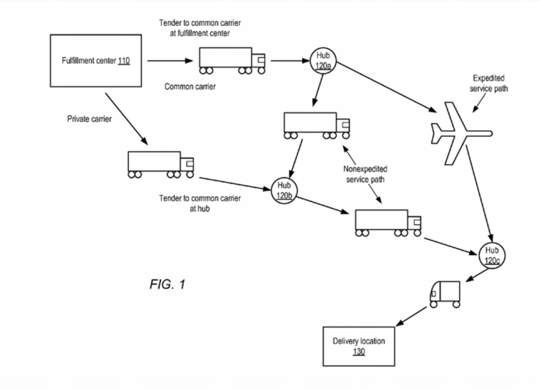 A diagram in Amazon’s patent for anticipatory shipping. Google Patents
A diagram in Amazon’s patent for anticipatory shipping. Google Patents
More immediate questions relate to Amazon’s entry in two stodgy yet critical industries: health care and financial services.
Although Amazon has disrupted many industries, these two are heavily regulated industries in which the company hasn’t had much experience.
Amazon is considering becoming a major player in the pharmaceutical and the health insurance markets. In May, it acquired online drugstore PillPack for $1 billion to crack the $500 billion market for prescription drugs and has formed a joint health venture with Berkshire Hathaway and JP Morgan Chase.
Meanwhile, with 310 million customer accounts, Amazon is building a suite of high-tech financial services, such as Amazon Cash, a way to add cash to your online balance, and Amazon Pay, an online payment service. These programs are aimed at developing markets such as India, which has a huge population that does not use banks.
Amazon has reshaped retailing permanently in the last 25 years. In the next 25, it might totally redefine how the world shops.![]()
About The Author
Venkatesh Shankar, Professor of Marketing; Director of Research, Center for Retailing Studies, Texas A&M University
This article is republished from The Conversation under a Creative Commons license. Read the original article.
Recommended books:
Capital in the Twenty-First Century
by Thomas Piketty. (Translated by Arthur Goldhammer)
 In Capital in the Twenty-First Century, Thomas Piketty analyzes a unique collection of data from twenty countries, ranging as far back as the eighteenth century, to uncover key economic and social patterns. But economic trends are not acts of God. Political action has curbed dangerous inequalities in the past, says Thomas Piketty, and may do so again. A work of extraordinary ambition, originality, and rigor, Capital in the Twenty-First Century reorients our understanding of economic history and confronts us with sobering lessons for today. His findings will transform debate and set the agenda for the next generation of thought about wealth and inequality.
In Capital in the Twenty-First Century, Thomas Piketty analyzes a unique collection of data from twenty countries, ranging as far back as the eighteenth century, to uncover key economic and social patterns. But economic trends are not acts of God. Political action has curbed dangerous inequalities in the past, says Thomas Piketty, and may do so again. A work of extraordinary ambition, originality, and rigor, Capital in the Twenty-First Century reorients our understanding of economic history and confronts us with sobering lessons for today. His findings will transform debate and set the agenda for the next generation of thought about wealth and inequality.
Click here for more info and/or to order this book on Amazon.
Nature's Fortune: How Business and Society Thrive by Investing in Nature
by Mark R. Tercek and Jonathan S. Adams.
 What is nature worth? The answer to this question—which traditionally has been framed in environmental terms—is revolutionizing the way we do business. In Nature’s Fortune, Mark Tercek, CEO of The Nature Conservancy and former investment banker, and science writer Jonathan Adams argue that nature is not only the foundation of human well-being, but also the smartest commercial investment any business or government can make. The forests, floodplains, and oyster reefs often seen simply as raw materials or as obstacles to be cleared in the name of progress are, in fact as important to our future prosperity as technology or law or business innovation. Nature’s Fortune offers an essential guide to the world’s economic—and environmental—well-being.
What is nature worth? The answer to this question—which traditionally has been framed in environmental terms—is revolutionizing the way we do business. In Nature’s Fortune, Mark Tercek, CEO of The Nature Conservancy and former investment banker, and science writer Jonathan Adams argue that nature is not only the foundation of human well-being, but also the smartest commercial investment any business or government can make. The forests, floodplains, and oyster reefs often seen simply as raw materials or as obstacles to be cleared in the name of progress are, in fact as important to our future prosperity as technology or law or business innovation. Nature’s Fortune offers an essential guide to the world’s economic—and environmental—well-being.
Click here for more info and/or to order this book on Amazon.
Beyond Outrage: What has gone wrong with our economy and our democracy, and how to fix it -- by Robert B. Reich
 In this timely book, Robert B. Reich argues that nothing good happens in Washington unless citizens are energized and organized to make sure Washington acts in the public good. The first step is to see the big picture. Beyond Outrage connects the dots, showing why the increasing share of income and wealth going to the top has hobbled jobs and growth for everyone else, undermining our democracy; caused Americans to become increasingly cynical about public life; and turned many Americans against one another. He also explains why the proposals of the “regressive right” are dead wrong and provides a clear roadmap of what must be done instead. Here’s a plan for action for everyone who cares about the future of America.
In this timely book, Robert B. Reich argues that nothing good happens in Washington unless citizens are energized and organized to make sure Washington acts in the public good. The first step is to see the big picture. Beyond Outrage connects the dots, showing why the increasing share of income and wealth going to the top has hobbled jobs and growth for everyone else, undermining our democracy; caused Americans to become increasingly cynical about public life; and turned many Americans against one another. He also explains why the proposals of the “regressive right” are dead wrong and provides a clear roadmap of what must be done instead. Here’s a plan for action for everyone who cares about the future of America.
Click here for more info or to order this book on Amazon.
This Changes Everything: Occupy Wall Street and the 99% Movement
by Sarah van Gelder and staff of YES! Magazine.
 This Changes Everything shows how the Occupy movement is shifting the way people view themselves and the world, the kind of society they believe is possible, and their own involvement in creating a society that works for the 99% rather than just the 1%. Attempts to pigeonhole this decentralized, fast-evolving movement have led to confusion and misperception. In this volume, the editors of YES! Magazine bring together voices from inside and outside the protests to convey the issues, possibilities, and personalities associated with the Occupy Wall Street movement. This book features contributions from Naomi Klein, David Korten, Rebecca Solnit, Ralph Nader, and others, as well as Occupy activists who were there from the beginning.
This Changes Everything shows how the Occupy movement is shifting the way people view themselves and the world, the kind of society they believe is possible, and their own involvement in creating a society that works for the 99% rather than just the 1%. Attempts to pigeonhole this decentralized, fast-evolving movement have led to confusion and misperception. In this volume, the editors of YES! Magazine bring together voices from inside and outside the protests to convey the issues, possibilities, and personalities associated with the Occupy Wall Street movement. This book features contributions from Naomi Klein, David Korten, Rebecca Solnit, Ralph Nader, and others, as well as Occupy activists who were there from the beginning.
Click here for more info and/or to order this book on Amazon.



